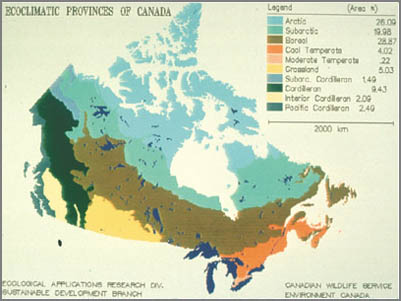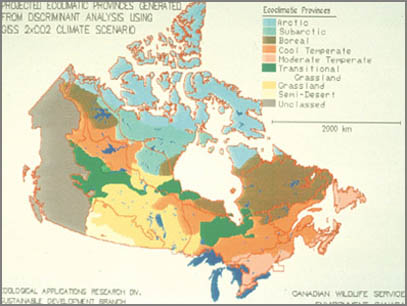 Today is Blog Action Day, with the focus on climate change and global warming.
Today is Blog Action Day, with the focus on climate change and global warming.
As I sat down to write this article, I glanced out my window and sighed. A very early snowfall has covered the ground, and record low temperatures have frozen the green leaves on the trees. Hardly the scene to prompt you to think about global warming, but Canadians have learned to take it in their stride.
Something Canadians should not accept with a fatalistic shrug however, is the effect of global warming on our Boreal forest.
The Canadian Boreal forest covers 6 million square kilometres and in many ways, defines Canada. It is adapted to cool northern temperatures and consists largely of evergreen conifers such as spruce and fir trees. It is also significant for its vast storage of water reserves in wetlands, lakes and rivers.
This forest is vital to the abundance of bird life in North America. Nearly 50% of the 700 species that regularly occur in the US and Canada rely on the Boreal for their survival. Over 300 species regularly breed there, and each spring up to three billion birds fly north to reach their breeding grounds.
The Boreal Songbird Initiative website states:
The responsibility of the Boreal forest in sustaining some bird populations is startling:
· 80% of the waterfowl species of North America, 63% of the finch species, and 53% of warbler species breed in the Boreal.
· For nearly 100 species, 50% or more of their entire breeding populations occur in the Boreal.
· Over 80% of the North American populations of 35 species are found in the Boreal
Having grown up in the Boreal forest, I could perhaps be forgiven for thinking it is unassailable, and will be around forever. But I would be wrong.
Our northern climate has shaped the Boreal. For much of the year, the forest is locked in a seasonal cold freeze, sometimes down to minus 40C in the depths of winter. The short summer brings long, warm periods of daylight that lead to rapid forest growth.
Climate change affects the forest ecosystem in many ways: temperatures increase, rainfall and humidity change and soils become drier. Overall, the Boreal forest is likely to decrease in area, with a significant disruption at its southern boundary. Taken together, these impacts could add up to an alarming 65 percent loss of this vital forest.*
Warmer winter temperatures are already one of the causes of the rapid spread of the mountain pine beetle. Increased temperatures also mean more forest fires, reduced tree growth, and less tree reproduction.
If the trees are unable to reproduce, native grasses will take over. Birds and other wildlife that depend on trees will move further north seeking cooler climates. Already bird species like the crossbills, who depend entirely on the cones produced by evergreens, are moving slowly northward. But there is only so much north in Canada – the trees stop growing on the edge of the tundra.
Scientists have determined that mosquitoes in the Hudson’s Bay area are appearing and reaching peak numbers earlier in the year. But the sea birds who nest there have not adjusted their behaviour, and the heat and insects are resulting in high egg loss and adult mortality. Loons are arriving earlier and staying later in the north. The parasitic brown-headed cowbird, a prairie dweller who relies on other species to raise their young, is happily increasing their range northwards, to the detriment of even more songbird populations.
Many studies have been done confirming birds are moving their breeding ranges further north, as much as 400 km further. In some areas, more than 90% of birds have already shifted their range, and many are arriving earlier and staying later. Examples of the results of global warming are endless in the bird world.

Ecoregions of Canada before climate change

Projected ecoregions of Canada after climate change
These maps from the Canadian Wildlife Service are an excellent illustration of the horror story unfolding in our Boreal forest, and across the country. So while I may sigh and moan about an early snowfall, climate change is clearly well underway in Canada. And it scares the hell out of me.
Sources:
Boreal Songbird Initiative
Nature Canada
*Climate Change and the Northern Forests



Thanks for explaining about the boreal forest. When I read scary things like this my ostrich tendencies try to surface. I love your site though and admire your writing.
Keep doing what you’re doing. I’ll try to remember to come back and read.
Pat,
A wonderful look at the challenges birds that breed in the boreal forest are faced with in a changing climate. So glad you found the Nature Canada site helpful for this post!
Hey! Climate change sure is a huge issue for the Boreal. Another thing that is speeding up its destruction is foresting, oil and gas exploration, mining, sadly the list goes on. In Ontario, legislation has been put in place to protect the Boreal from Deforestation but it has not been enacted. The Woodland Caribou who are currently listed as threatened depend on this bill. I thought you might like to know about a current campaign that is running to get Dalton McGuinty to enact the piece of legislation that will protect vital habitat in Ontario’s portion of the Boreal forest. You can sign an email to McGuinty here: http://bit.ly/491Osl, follow the campaign on twitter at twitter.com/savethebou or join the Facebook Group http://bit.ly/vCoTe. Losing large portions of the Boreal will certainly speed up climate change. I hope this campaign makes you feel like you were able to do some good for your former home.
A very educational post. I applaud you for writing about this topic and bringing awareness to the forefront!
Great post! Scares the heck out of me too!
Pingback: Tweets that mention Blog for the Boreal -- Topsy.com